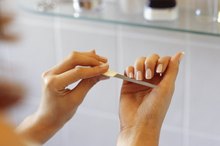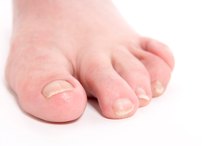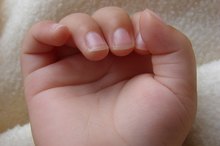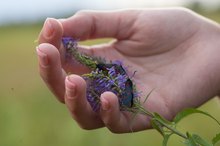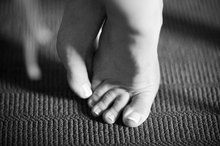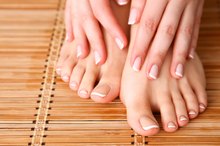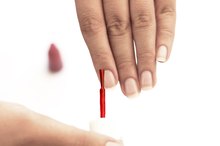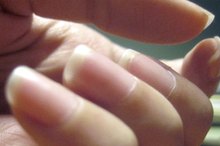Signs of Kidney Disease in Fingernails
The appearance of your fingernails can change with certain medical conditions 2. Kidney disease is associated with multiple distinctive nail problems 3. A buildup of nitrogen waste products occurs in the bodies of people with kidney disease, which can lead to changes in finger and toenails. Other conditions such as malnutrition and medications can contribute to changes in the nails. See your doctor for an accurate diagnosis if you notice changes in your fingernails.
Linear Depressions
One type of nail change is called Beau's lines -- transverse ridges that go across the nail, affecting all of your nails. Beau's lines are a result of an acute kidney disease that interferes with the growth of the nail.
Ridged Nails
Symptoms of Malnutrition in the Fingernails
Learn More
Kidney disease causes koilonychia -- ridged nails that are somewhat spoon-shaped and concave. This change is associated with iron-deficiency anemia, which commonly occurs in people with kidney disease.
White Streaks and Spots
White streaks and spots on your fingernails occur with a condition called leukonychia. This condition is associated with chronic renal disease.
Half-and-Half Nails
What Do Ridges in Toenails Mean?
Learn More
Half-and-half nails -- also known as Lindsay's nails -- also occur with kidney disease. The bottom portion of the nail is white, while the top of your nail is brown. Swelling of the nail bed causes the bottom of the nail to become white.
Brittle Nails
Brittle nails may chip or crack easily. While brittle nails are a common sign of aging, they also occur in people with kidney disease.
Related Articles
References
- Journal of Proteome Research: Proteomic Analysis of Human Nail Plate
- Pediatric Nephrology: Kidney Disease in Nail–Patella Syndrome
- New Zealand Dermatological Society: Nail Diseases
- Singal A, Arora R. Nail as a window of systemic diseases. Indian Dermatol Online J. 2015;6(2):67-74. doi:10.4103/2229-5178.153002
- Yaemsiri S, Hou N, Slining MM, He K. Growth rate of human fingernails and toenails in healthy American young adults. J Eur Acad Dermatol Venereol. 2010;24(4):420-3. doi:10.1111/j.1468-3083.2009.03426.x
- Schons KR, Knob CF, Murussi N, Beber AA, Neumaier W, Monticielo OA. Nail psoriasis: a review of the literature. An Bras Dermatol. 2014;89(2):312-7. doi:10.1590/abd1806-4841.20142633
- Abdullah L, Abbas O. Common nail changes and disorders in older people: Diagnosis and management. Can Fam Physician. 2011;57(2):173-81.
- Sarkar M, Mahesh DM, Madabhavi I. Digital clubbing. Lung India. 2012;29(4):354-62. doi:10.4103/0970-2113.102824
- Haneke E. Controversies in the treatment of ingrown nails. Dermatol Res Pract. 2012;2012:783924. doi:10.1155/2012/783924
- Jefferson J, Rich P. Melanonychia. Dermatol Res Pract. 2012;2012:952186. doi:10.1155/2012/952186
- Aging Changes in Hair and Nails. Medline. National Institutes of Health Public Information Sheet.
- Nails and Nail Problems. American Academy of Dermatology Public Information Sheet.
Writer Bio
Dominique Brooks has been a medical editor for over 10 years. She has worked in medical education for physicians, nurses and pharmacists as well as consumers. She started writing business articles for Work.com in 2008 and health articles online in 2009. She holds a Master of Business Administration from the University of Alabama and a Doctor of Medicine from Vanderbilt University.
